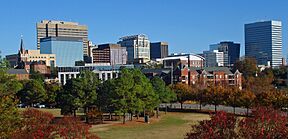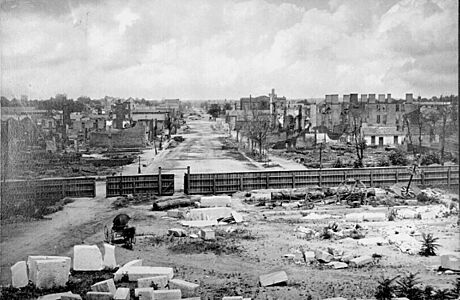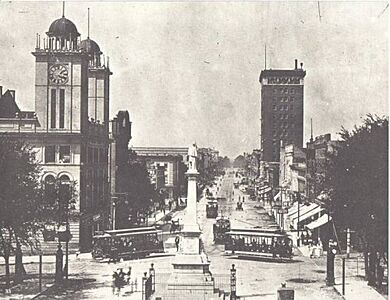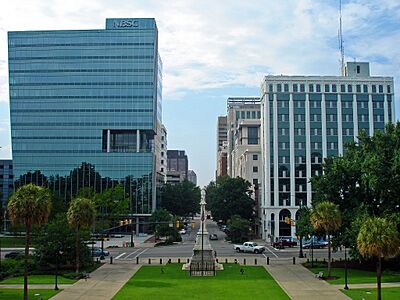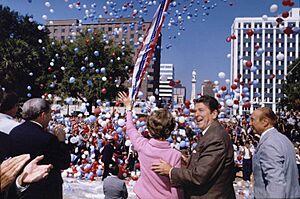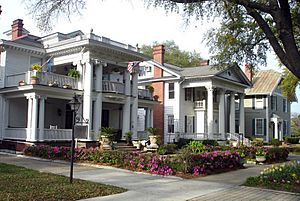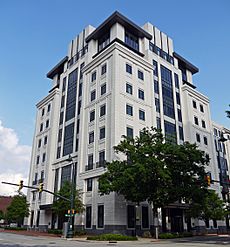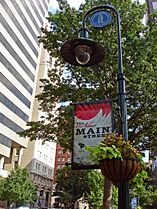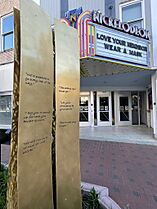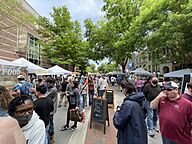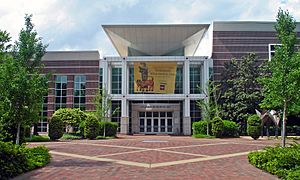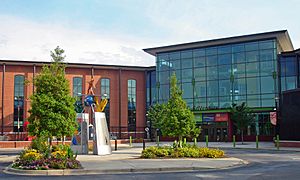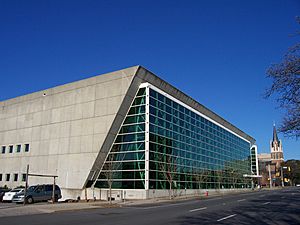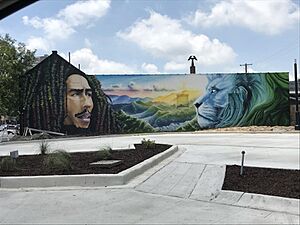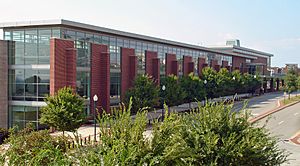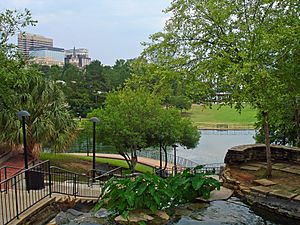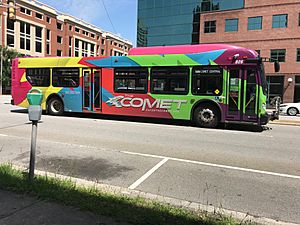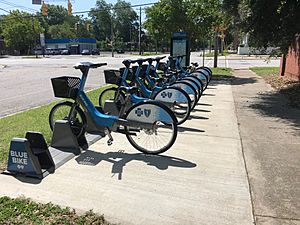Columbia, South Carolina facts for kids
Quick facts for kids
Columbia
|
|||
|---|---|---|---|
|
Downtown Columbia skyline
The Seibels House
Williams-Brice Stadium
Horseshoe at the University of South Carolina
|
|||
|
|||
| Nicknames:
Cola, Capital City, River City, Soda City
|
|||
| Motto(s): | |||
| Country | United States | ||
| State | South Carolina | ||
| County | Richland, Lexington | ||
| Approved | March 22, 1786 | ||
| Chartered (town) | 1805 | ||
| Chartered (city) | 1854 | ||
| Named for | Columbia | ||
| Area | |||
| • Total | 140.68 sq mi (364.37 km2) | ||
| • Land | 137.81 sq mi (356.93 km2) | ||
| • Water | 2.87 sq mi (7.44 km2) 1.68% | ||
| Elevation | 302 ft (92 m) | ||
| Population
(2020)
|
|||
| • Total | 136,632 | ||
| • Estimate
(2023)
|
142,416 | ||
| • Rank | 205th in the United States 2nd in South Carolina |
||
| • Density | 991.45/sq mi (382.80/km2) | ||
| • Urban density | 1,606.6/sq mi (620.3/km2) | ||
| • Metro | 858,302 (US: 70th) | ||
| Time zone | UTC−5 (EST) | ||
| • Summer (DST) | UTC−4 (EDT) | ||
| ZIP code(s) |
29044, 29201–29212, 29214–29230, 29240, 29250, 29260, 29290, 29292
|
||
| Area code(s) | 803, 839 | ||
| FIPS code | 45-16000 | ||
| GNIS feature ID | 1245051 | ||
Columbia is the capital city of South Carolina, a state in the United States. It's the second-largest city in South Carolina. About 136,632 people lived here in 2020. Columbia is also the main city of a larger area called the Columbia Metropolitan Statistical Area, where over 858,000 people live.
The city's name, Columbia, is a poetic way to refer to the United States. It comes from Christopher Columbus. People sometimes call Columbia "Cola" or "Soda City" for short.
Columbia is located near the middle of South Carolina. It sits where the Saluda River and the Broad River meet to form the Congaree River. As the state capital, Columbia is home to the South Carolina State House, which is where the state government works. In 1860, South Carolina decided to leave the United States here, leading up to the Civil War.
The city is also home to the University of South Carolina, a large public university. Columbia has strong ties to the military. Fort Jackson, a major United States Army training base, is located here. Nearby, McEntire Joint National Guard Base is used by the U.S. Air Force for training.
Contents
History of Columbia
How Columbia Began

In 1540, a Spanish group led by Hernando de Soto traveled through this area. They wrote the first records of the land, which was home to the Cofitachequi people.
Later, European settlers met the Congaree people living along the Congaree River. The settlers built a fort and trading post named after the Congaree. This spot was important because it was at the "fall line." This is where rivers drop quickly to lower levels, creating rapids. Boats couldn't go further upstream, making it a good place for trade and later, for mills powered by the water.
In 1754, the government set up a ferry to connect the fort with growing settlements on the other side of the river.
Becoming the State Capital
After the American Revolutionary War, South Carolina needed a new state capital. State Senator John Lewis Gervais suggested creating a new city. On March 22, 1786, the idea was approved. There was a big discussion about the name. Senator Gervais wanted it to be called "Columbia," and that name won.

Columbia was chosen because it was in the center of the state. The State Legislature first met there in 1790. Columbia became a village in 1805 and a city in 1854.
The city grew a lot when the Santee Canal was built. This canal connected Columbia to Charleston by water. It was one of the first canals in the U.S., finished in 1800. However, it stopped being used around 1850 because railroads became faster.
The city was planned with 400 blocks in a 2-mile square. The streets were very wide, which was unusual for the time. This careful planning helped Columbia grow quickly. By the early 1800s, almost 1,000 people lived there.
Columbia in the 1800s
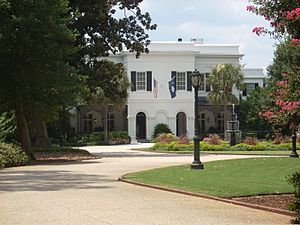
In 1801, South Carolina College (now the University of South Carolina) was started in Columbia. It was placed here to help unite people from different parts of the state. The college was very important to state leaders.
Columbia became a town in 1805 and a city in 1854. By 1816, it had over 1,000 residents. In the 1850s and 1860s, Columbia was the largest inland city in the Carolinas. Railroads helped it grow by transporting cotton, which was very important to the city's economy. Many people, including enslaved individuals, worked in the cotton industry and other jobs in Columbia during this time.
The Civil War in Columbia
Columbia was very important to the Confederacy during the American Civil War. The first Southern state to leave the Union, South Carolina, voted for secession here in December 1860. Columbia had military facilities, an arsenal, and factories making war supplies.

In February 1865, the Union Army, led by General William T. Sherman, captured Columbia. Much of the city was destroyed by fire. While some believed Sherman ordered the burning, historians today say that the fires started and spread due to the chaotic situation in the city.
After the War: Reconstruction
After the Civil War, during the Reconstruction era, Columbia became a center of attention. African Americans, who had been enslaved, were elected to the state government. The city began to rebuild from the fire. Railroad tracks were repaired, creating more jobs.
By the late 1800s, culture in the city grew. The Columbia Music Festival Association was started in 1897 to bring concerts and events to the city's Opera House.
Columbia in the 1900s
- Three images taken from the same location showing Columbia's Main Street from Statehouse steps
-
Columbia in ruins after burning at the end of the Civil War, c. 1865
In the early 1900s, Columbia became a major textile manufacturing center. By 1907, six mills employed over 3,400 workers. This brought a lot of money into the area. Columbia didn't have paved streets until 1908. Before that, people used wooden boardwalks to cross muddy intersections.
New buildings were constructed in 1911 and 1912, including banks and hotels. In 1917, the U.S. Army chose Columbia for Camp Jackson, a military training base. This base became permanent and was renamed Fort Jackson.
During the 1940s, African Americans in Columbia began to fight for equal rights. In 1945, a judge ruled that Black teachers should be paid the same as white teachers. People also worked to gain voting rights and end segregation in public places and schools. In 1954, the U.S. Supreme Court ruled that segregated schools were illegal.
By the 1960s, many signs of segregation started to disappear. Black citizens joined city boards, and the city adopted fair hiring policies. Because of this progress, Columbia won the "All-America City Award" in 1964.
Since the late 1900s, people in Columbia have worked to save and restore historic buildings. The Robert Mills House was restored in 1967, inspiring other projects. Museums like the South Carolina State Museum also opened or grew.
In the 1970s and 1980s, new skyscrapers were built downtown. The Capitol Center, built in 1987, became the tallest building in South Carolina.
Columbia in the 2000s
In the 1990s and early 2000s, Columbia worked to bring life back to its downtown area. The Congaree Vista district, once a warehouse area, became a place with art galleries, shops, and restaurants. The Colonial Life Arena opened in 2002, bringing big shows to the city. EdVenture, a large children's museum, opened in 2003.
The Columbia Metropolitan Convention Center opened in 2004. A group called the City Center Partnership works to help downtown grow. In 2009, a new skyscraper, the Tower at Main and Gervais, was finished. In 2010, Stephen K. Benjamin became the first African-American mayor of Columbia.

Sports teams in Columbia have also had success. The Gamecocks women's basketball team won national championships in 2017, 2022, and 2024. The baseball team won championships in 2010 and 2011. A new baseball stadium, Segra Park, opened in 2016 for the Columbia Fireflies minor league team.
In 2015, the Confederate battle flag was moved from the State House grounds to a museum. In August 2017, a total solar eclipse passed directly over Columbia.
In 2021, Daniel Rickenmann was elected mayor.
Geography of Columbia
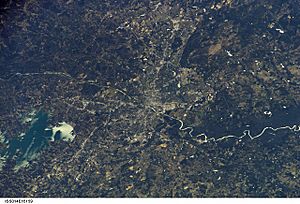

Columbia is located at the "fall line," which is where the higher Piedmont region meets the lower Atlantic Coastal Plain. Rivers here drop as falls or rapids. This is why Columbia is at the meeting point of the Broad and Saluda rivers, which form the Congaree River. This spot was the farthest inland that boats could travel on the river.
The city is about halfway between the Atlantic Ocean and the Blue Ridge Mountains. Its elevation is around 292 feet (92 meters).
Columbia is known for its hot summers. It averages 72 days a year with temperatures above 90°F (32°C). The city's slogan is "Famously Hot." This is partly because of its lower elevation compared to other cities and because it's in the sandy Sandhills region, which heats up quickly.
The highest temperature ever recorded in South Carolina was 113°F (45°C) in Columbia on June 29, 2012. Winters are usually mild, with about 55 nights below freezing. Snowfall is rare, averaging only 1.5 inches (3.8 cm) per year.
Columbia's Metropolitan Area
The Columbia metropolitan area is the second-largest in South Carolina. It includes several counties and towns around Columbia.
Some of the counties in the Columbia metropolitan area are:
Some of the towns and suburbs near Columbia are:
Columbia's Neighborhoods
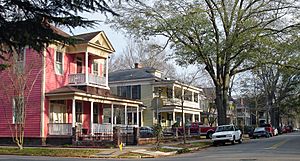
Columbia has many different neighborhoods, each with its own character. Some well-known neighborhoods include:
- Arsenal Hill
- Congaree Vista
- Eau Claire
- Elmwood Park
- Five Points
- Forest Acres
- Heathwood
- Rosewood
- Shandon
- Waverly Historic District
People of Columbia
| Historical population | |||
|---|---|---|---|
| Census | Pop. | %± | |
| 1830 | 3,310 | — | |
| 1840 | 4,340 | 31.1% | |
| 1850 | 6,060 | 39.6% | |
| 1860 | 9,052 | 49.4% | |
| 1870 | 12,298 | 35.9% | |
| 1880 | 10,036 | −18.4% | |
| 1890 | 15,353 | 53.0% | |
| 1900 | 21,108 | 37.5% | |
| 1910 | 26,319 | 24.7% | |
| 1920 | 37,524 | 42.6% | |
| 1930 | 51,581 | 37.5% | |
| 1940 | 62,396 | 21.0% | |
| 1950 | 86,914 | 39.3% | |
| 1960 | 97,433 | 12.1% | |
| 1970 | 112,542 | 15.5% | |
| 1980 | 108,208 | −3.9% | |
| 1990 | 110,852 | 2.4% | |
| 2000 | 116,278 | 4.9% | |
| 2010 | 129,272 | 11.2% | |
| 2020 | 136,632 | 5.7% | |
| 2023 (est.) | 142,416 | 10.2% | |
| U.S. Decennial Census | |||
In 2020, Columbia had 136,632 people. The city is made up of many different racial and ethnic groups. About 49% of the people are White, and about 38% are Black or African American. There are also growing Asian and Hispanic/Latino communities.
The average age in Columbia is 29 years old. Many young people live here because of the universities and colleges.
Columbia has many different religious groups. There are many Christian churches, including Baptist, Methodist, and Lutheran. There are also Catholic churches, Jewish synagogues, Islamic mosques, and Hindu temples.
Columbia's Economy
Columbia has a strong and varied economy. The biggest employers are the South Carolina state government, the Prisma Health hospital system, and the University of South Carolina. Other major employers include Blue Cross Blue Shield of South Carolina and Fort Jackson.
Many large companies have offices or factories in the Columbia area. These include Michelin, International Paper, and Westinghouse Electric. Over 70 foreign companies have facilities here. Several companies also have their main headquarters in Columbia, such as Colonial Life & Accident Insurance Company and AgFirst Farm Credit Bank.
Downtown Revitalization Efforts
Columbia has been working to improve its downtown area. The historic Congaree Vista district has been transformed. Old buildings are now art galleries, restaurants, and shops. The area also has the city's convention center and hotels.
Main Street is also being revitalized. New buildings have been constructed, and historic storefronts have been restored. A large project called Columbia Common is underway on an old mental health campus. It will include homes, hotels, shops, and a minor league baseball stadium.
Soda City Market
The Soda City Market is a popular outdoor market that started in 2005. Every Saturday, Main Street closes to cars, and about 150 vendors sell handmade goods, local produce, food, and art. Thousands of people visit the market each week.
Military Bases in Columbia
- Fort Jackson is the U.S. Army's largest training base.
- McEntire Joint National Guard Base is run by the South Carolina Air National Guard.
Arts and Culture in Columbia
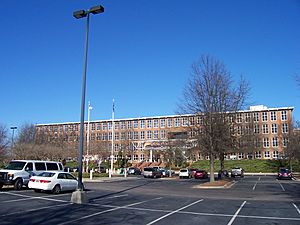
Columbia has a lively arts and culture scene. Here are some of the places and groups that make it special:
- Busted Plug Plaza: This is where you can find the world's largest fire hydrant sculpture, created by local artist Blue Sky.
- Columbia City Ballet: Columbia's own ballet company performs over 80 shows each year.
- Columbia Museum of Art: This museum features different art exhibits throughout the year.
- EdVenture: One of the largest children's museums in the Southeast, where kids can learn and have fun.
- McKissick Museum: Located at the University of South Carolina, it shows art, science, and history exhibits.
- Nickelodeon Theater: This non-profit theater shows art-house films and is the only one of its kind in South Carolina.
- Richland County Public Library: This library was named the National Library of the Year in 2001. It has a huge collection of books and offers many services.
- South Carolina State Museum: The largest museum in the state, with exhibits on science, technology, history, and art.
- Town Theatre: The oldest community theater in continuous use, performing plays and musicals since 1917.
Event Venues in Columbia
- Columbia Metropolitan Convention Center: This large facility opened in 2004 and hosts many meetings and conventions. It's located near restaurants and shops.
- Koger Center for the Arts: This center hosts theater, music, and dance performances. It seats over 2,200 people.
- Carolina Coliseum: Opened in 1968, this arena used to be home to the USC Gamecocks basketball teams. It now serves as a practice facility.
- Township Auditorium: This historic building, built in 1930, hosts concerts, conventions, and other events. It seats over 3,000 people and has been recently renovated.
Sports in Columbia
| Club | Sport | Founded | League | Venue | Capacity |
|---|---|---|---|---|---|
| SC Gamecocks football | American football | 1892 | SEC | Williams-Brice Stadium | 80,250 |
| SC Gamecocks women's basketball | Basketball | 1974 | SEC | Colonial Life Arena | 18,000 |
| SC Gamecocks men's basketball | Basketball | 1908 | SEC | Colonial Life Arena | 18,000 |
| Columbia Fireflies | Baseball | 2016 | Carolina League | Segra Park | 9,077 |
| SC United Bantams | Soccer | 2011 | USL2 | Southeastern Freight Lines Soccer Center | 2,000 |
| Columbia Olde Grey | Rugby Union | 1967 | USA Rugby | Patton Stadium |
The most popular sports in Columbia are the teams at the University of South Carolina. Columbia also has minor league and amateur sports teams.
Sports Venues in Columbia
- Williams-Brice Stadium: This is the home of the USC Gamecocks football team. It's the 24th largest college football stadium in the U.S., seating over 80,000 people. It was built in 1934 and later renamed to honor the Williams and Brice families.
- Colonial Life Arena: Opened in 2002, this is the largest arena in South Carolina. It seats 18,000 people and is home to the USC Gamecocks men's and women's basketball teams.
- Charlie W. Johnson Stadium: This stadium is home to Benedict College's football and soccer teams. It seats 11,000 people.
- Founders Park: Opened in 2009, this is the largest college baseball stadium in South Carolina. It seats 8,400 people and is home to the University of South Carolina Gamecocks baseball team.
- Segra Park: This baseball stadium opened in 2016 and is home to the Columbia Fireflies, a Minor League Baseball team. It can seat up to 7,501 people.
Parks and Recreation in Columbia
Columbia has many parks and outdoor spaces for people to enjoy.
- Finlay Park: This 18-acre park hosts many events, from festivals to concerts. It was first dedicated in 1859 as Sidney Park. After falling into disrepair, it reopened in 1990 and was renamed Finlay Park in 1992. The park is currently being redesigned to include a new fountain, stage, and gardens.
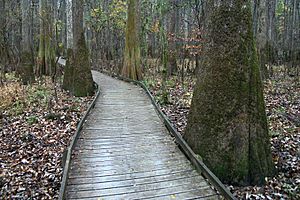
- Memorial Park: This park honors those who served the country. It has monuments for the USS Columbia warship, WWII veterans, Pearl Harbor victims, Holocaust survivors, and Vietnam War veterans.
- Granby Park: Opened in 1998, this park is part of the Three Rivers Greenway. It has canoe access, fishing spots, and a nature trail along the Congaree River.
- Martin Luther King Jr. Park: Located in the Five Points district, this park honors the civil rights leader. It features a water sculpture and the Stone of Hope monument.
- Riverbanks Zoo & Garden: This popular attraction is home to over 2,000 animals in natural habitats. It also has a 70-acre botanical garden. Riverbanks has been named one of America's best zoos.
- Congaree National Park: This large park protects the biggest area of old-growth bottomland hardwood forest in the U.S. It's known for its giant trees and diverse wildlife. You can walk on boardwalks through the swamp.
- Sesquicentennial State Park: This 1,419-acre park has a 30-acre lake, trails, and picnic areas. It's a popular spot for family reunions and camping. The park also has a log house from the 1700s, believed to be the oldest building in Richland County.
- Three Rivers Greenway: This is a planned system of parks and trails along the banks of Columbia's rivers. It aims to connect people to the rivers for recreation like walking, running, and fishing.
- Riverfront Park: This park runs beside the historic Columbia Canal and has a 2.5-mile trail for walking, running, and biking. An old railway bridge over the canal is now a pedestrian walkway.
Other parks in the Columbia area include:
- W. Gordon Belser Arboretum
- Maxcy Gregg Park
- Hyatt Park
- Earlewood Park
- Owens Field Park
- Guignard Park
- Southeast Park
- Harbison State Forest
Education in Columbia
Colleges and Universities
Columbia is home to many colleges and universities:
- University of South Carolina: This is the main campus of the state's flagship public university. It offers over 350 degree programs and has over 31,000 students.
- Allen University: A private, historically Black university founded in 1870.
- Benedict College: Another independent, historically Black college founded in 1870.
- Columbia College: A private liberal arts college for women, founded in 1854.
- Columbia International University: A private Christian university focused on Christian leadership.
- Lutheran Theological Southern Seminary: One of the oldest Lutheran seminaries in North America, founded in 1830.
- Midlands Technical College: A two-year community college offering career education and transfer programs.
Public Schools
Most of Columbia is served by Richland County School District One. Other parts are served by Richland County School District Two and Lexington & Richland County School District Five.
Private Schools
Columbia has many private schools, including:
- Ben Lippen School
- Cardinal Newman
- Covenant Classical Christian School
- Glenforest School
- Hammond School
- Heathwood Hall
- Montessori School of Columbia
- Northside Christian Academy
- Sandhills School
- Saint Joseph Catholic School
- Timmerman School
Media in Columbia
Columbia's daily newspaper is The State. Other local newspapers include The Columbia Star and Carolina Panorama Newspaper. The University of South Carolina has a student-run newspaper called The Daily Gamecock.
Columbia is also home to the headquarters of South Carolina Educational Television and South Carolina Public Radio, which are the state's public TV and radio networks.
The city has several TV stations, including WIS (NBC), WLTX (CBS), WACH (Fox), and WOLO (ABC). The University of South Carolina has a student-run radio station, WUSC-FM.
Transportation in Columbia
Public Transportation
The Comet is the public transportation system in Columbia. It operates buses and express shuttles throughout the city and nearby areas. The Comet also offers special services for people with disabilities. The University of South Carolina has its own transit system, which is also managed by The Comet. You can also find rental bicycles in downtown Columbia.
Roads and Highways
Columbia is a central point for transportation in South Carolina. Several major highways pass through or near the city:
- Interstate 20 connects Columbia to cities like Atlanta and Augusta to the west, and Florence to the east.
- Interstate 26 links Columbia to the Greenville-Spartanburg area in the northwest and Charleston in the southeast.
- Interstate 77 goes north from Columbia to Rock Hill and Charlotte. It also provides direct access to Fort Jackson.
- Interstate 126 starts downtown and connects to I-26 and I-20.
Air Travel
The main airport for Columbia is Columbia Metropolitan Airport. It has flights from airlines like American Eagle, Delta Connection, and United Express. A smaller airport, Jim Hamilton–L.B. Owens Airport, is used for general aviation.
Train Travel
The city has an Amtrak station where you can catch the Silver Star trains. These trains connect Columbia to major cities like New York City, Washington, D.C., Orlando, and Miami.
Bus Travel
Greyhound Lines offers intercity bus transportation from a station on Buckner Road. MegaBus also has routes from Columbia to cities like Atlanta, Washington, D.C., and New York City.
Awards and Achievements
Columbia has received several awards. In 2009, U.S. News & World Report listed Columbia as one of the best places to retire. In 2013, Kiplinger Magazine named it one of "10 Great Cities to Live In." The city has also been called one of "America's Most Livable Communities."
Sister Cities
The city of Columbia has several sister cities around the world. These partnerships help promote cultural understanding and friendship. Columbia's sister cities include:
 Kaiserslautern, Germany
Kaiserslautern, Germany Cluj-Napoca, Romania
Cluj-Napoca, Romania Plovdiv, Bulgaria
Plovdiv, Bulgaria Chelyabinsk, Russia
Chelyabinsk, Russia Yibin, China
Yibin, China Accra, Ghana
Accra, Ghana Taichung City, Taiwan
Taichung City, Taiwan- Columbia, Mississippi, USA
Images for kids
-
Robert Mills House, built 1823
-
Troops returning from World War I march through Columbia, April 1919
-
President Woodrow Wilson's family home
-
Woodrow Wilson, the 28th president of the United States, lived in Columbia during his youth.
-
Esplanade at Columbia Canal
See also
 In Spanish: Columbia (Carolina del Sur) para niños
In Spanish: Columbia (Carolina del Sur) para niños


